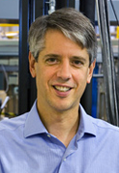 I welcome all members of the ALS community back for a new year. We had a fine 2011 that included an excellent review by the Department of Energy as well as the launching of a number of new activities. We are starting 2012 with the promise of healthy funding for both user operations and machine and beamline projects.
I welcome all members of the ALS community back for a new year. We had a fine 2011 that included an excellent review by the Department of Energy as well as the launching of a number of new activities. We are starting 2012 with the promise of healthy funding for both user operations and machine and beamline projects.
One of our primary jobs is to keep the ALS machine both reliable and at the forefront of synchrotron brightness. To accomplish this, we are upgrading our RF system with new klystrons, modernizing our control systems, and building new sextupole magnets to tighten the electron beam in the storage ring. These are long-term projects, some began under the stimulus funding in 2009, but all are on track, and those that require on-going funding have seen consistent support from DOE.
Another job we have is to work with users to develop new photon science capabilities that are needed for world-leading science. We are progressing well on beamline projects including MAESTRO (for nanoscale resolution photoemission studies), COSMIC (for advanced coherent scattering measurements and high-resolution diffractive imaging), and the SEMATECH EUV Project (supporting the industrial consortium that is developing the next generation of computer chips).
Many beamlines, including those supporting the basic science of sustainable energy technologies, benefit from partnerships with other divisions at LBNL. These include combustion studies with the Chemical Sciences Division (see this month’s science highlight on Criegee intermediates), battery studies with the Material Sciences Division, and carbon capture and sequestration studies with the Earth Sciences Division. These collaborations build on other activities, such as working on advanced data handling with the Computing Division, studying new systems for artificial photosynthesis with the Joint Center for Artificial Photosynthesis (JCAP Energy Hub), and of course our strong history of collaboration with the Engineering and Accelerator, and Fusion Research Divisions.
User demand continues to grow, but with anticipated flattening of funding in coming years, we may see a stabilization in total research output (for example the number of papers) from ALS users, as our capabilities to serve increasing numbers of users depends on our total number of staff. Of course, we work to be more efficient and we make trade offs in the capabilities we offer, as new and important activities grow.
To help our users better connect with the ALS, this year we are working on a new Web portal where users can submit proposals, arrange visits, learn about safety, communicate regarding experimental setup, and post publications.
Additional priorities for this year include bringing our construction projects to completion on time and on budget. We are working with partners to propose new beamlines, including AMBER, which will address the basic science of energy technologies under real, operational (in situ) conditions, a capability necessary for greater understanding of processes like catalysis or components such as fuel cells. We are continuing to explore ways of having more theoretical support for photon sciences, fielding high data rate x-ray detectors, and processing data in real time so that feedback to users doing experiments can help them be more productive.
There is a lot to learn about our activities at ALS, and I urge you to take a look at our website, especially if you haven’t recently (http://als.lbl.gov/). There we highlight our science, point toward fun activities such as our bi-monthly Science Cafés, and provide links to helpful information, encouraging all of you to participate in ALS planning.